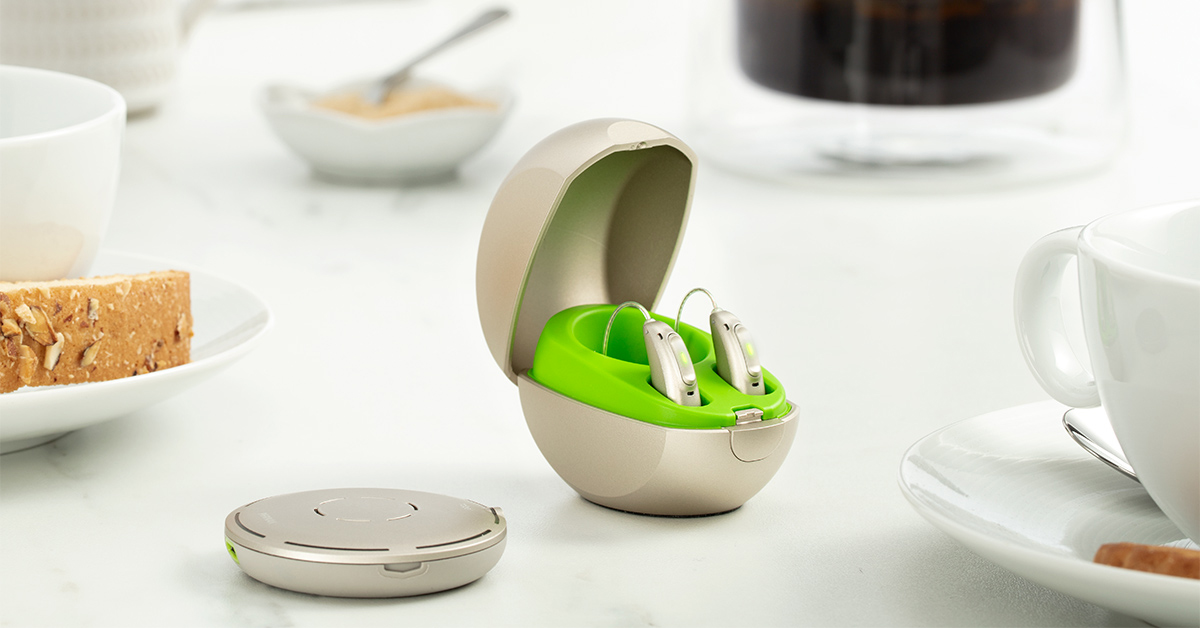Insights and Data Into the Success of Phonak Marvel
AudiologyOnline: Since the launch of Phonak Marvel in October 2018, what responses have you heard from hearing care providers and patients about its clear, rich sound and direct connectivity?

Nicole Klutz, AuD: We have heard overwhelmingly positive responses and feedback from both hearing care providers and patients wearing Marvel hearing aids. In fact, when surveyed, 91% of Audéo™ Marvel wearers would recommend Marvel to a friend or a loved one.
In addition, we surveyed hearing care providers who are fitting Phonak Marvel, and 95% of them would recommend Marvel hearing aids to their colleagues. This is an incredibly high success rate and performance with both patients and hearing care providers fitting Marvel.
With the launch of Phonak Marvel, we made some big promises, including the best first fit experience, universal connectivity with no compromise on performance, and a product that is truly an all-in-one solution. It is important to us that when we make such strong claims about performance that the product delivers.
I’m excited to say that this is exactly what we’re hearing from the hearing care providers who are fitting Marvel devices. In fact, 9 out of 10 hearing care providers reported that Marvel delivered the best first fit for first-time hearing aid wearers with exceptional sound quality right from the beginning. And, 92% of them confirm that the biggest advantage of Marvel is the combination of rechargeability and connectivity with no compromise on sound quality.
We couldn’t have asked for a more positive response to Marvel, and we are continuing to hear the great feedback with the latest Marvel 2.0 update that just in August 2019.
AudiologyOnline: Marvel was launched claiming the best first fit experience that Phonak has ever had. Do you have any insights into the experiences of first-time patients wearing Phonak Marvel?
Nicole Klutz, AuD: We all know how important it is to get that first fitting “right” with a new hearing aid wearer. You never get a second chance to make a great first impression, and for some first-time hearing aid wearers, that moment can be one that they never forget for the wrong reason.
For as long as I can remember, hearing care providers have had to compromise on first fit sound quality for comfort — meaning that they had to reduce the high frequencies (a.k.a. audibility) for many of their first fits to provide overall comfort to their patients so as not to give them a bad first experience. However, we all knew that this meant we were potentially under amplifying them, and often many patients never got up to their full potential within the first 6 months of their hearing aid experience.
With Marvel, our R&D team at headquarters in Switzerland spent a lot of time investigating ways in which we could provide an acoustically comfortable first fit without compromising on the high-frequency audibility we know is critical to speech understanding. This is one of the many things that is so unique with Marvel — our first fit algorithm and calculation — to ensure comfort without compromise.
After launching Marvel, we took a look at the ~76,000 fittings from 32,000 patients who had been fit across various countries (USA, DE, FR, CA, GB) and took a look at the parameters and fitting behaviors to see just what was really happening.
Right off the bat, we saw that the newly designed M receiver and Open dome were being used at first fit as recommended by Target fitting software, and that upon follow-up, there were no changes made to the acoustic coupling, meaning that the patient and the hearing care provider were happy with the fit.
When looking at first fit data, we can see that hearing care providers are using the first fit algorithm without any additional fine tuning for their first-time Marvel wearers. We also see that they are making minimal, if any, changes to the first fit program. Then, when appropriate, the fitting data reflects the hearing care provider moving the Marvel hearing aid wearer to the next step on their hearing journey and increasing their amplification as they become ready for it.
Overall, this tells us that not only is the first fit with Marvel widely accepted by both the patient and the hearing care provider, but that it is not requiring a lot of fine tuning and adjustment when fit. Hearing care providers are selecting the first fit and letting their patients experience the Marvel hearing aids without any need for fine tuning. When they’ve acclimated and are ready to experience more in their hearing journey, then they’re on their way!
AudiologyOnline: Marvel includes the automatic operating system AutoSense OS™ 3.0. How is automatic hearing aid technology evolving so quickly? And, what can patients and hearing care providers expect from it?
Nicole Klutz, AuD: AutoSense OS is the operating system of many Phonak hearing aid platforms. It is extremely important in how the patient experiences his/her world around him/her as well as how the hearing care provider can confidently fit a patient who has a very dynamic listening environment.
AutoSense OS is unlike any other automatic operating system in hearing aids. Unique to Phonak, AutoSense OS is multi-based and has the intelligence to analyze the acoustic environment and select to blend components of the programs within it to match the patients environment and optimize their settings whatever it is that they need at that time.
It is important, though, that we recognize that AutoSense OS needs to continue to evolve, and the system needs to be continually refined to optimize its acoustic classification and recognition of very dynamic and challenging listening environments.
With Marvel and AutoSense OS 3.0 we introduced a new capability for AutoSense OS: classification of streamed signals. Along with classification of streamed inputs, AutoSense OS 3.0 can also identify if the signal is streamed speech (like a podcast) or streamed music (like a movie scene) and adapt the setting accordingly to optimize what the patient is hearing to ensure a full, rich sound quality. AutoSense OS 3.0 is the only automatic system available to do this.
Both hearing care providers and Marvel wearers can expect and enjoy the full, rich, top-rated streamed sound quality that only Marvel and AutoSense OS 3.0 can offer.
AudiologyOnline: Marvel offers direct connectivity to any Bluetooth®-enabled device and is Made-for-All; however, are patients using the connectivity options?
Nicole Klutz, AuD: Marvel pushed the boundaries of direct connectivity in hearing aids with the Made-for-All connection to any Bluetooth®-enabled device as well as iPhone and Android™ phones. We have seen a strong shift in hearing aid innovation and technology to meet the technological needs and demands of our patients today. We are all connected to something or one another via our phones, wireless technology and the internet. So why shouldn’t our hearing aids be connected too?
When developing Marvel, it was very clear that Phonak wanted to offer a solution that could connect to any phone, no matter the operating system, and any Bluetooth device. With this promise of universal connectivity comes an overwhelming responsibility to achieve and perform. And Marvel has!
Marvel is connecting to smartphones, TVs, sound systems — you name it. We have heard positive responses and feedback to the direct connectivity capabilities of Marvel, and as we’ve just seen with Marvel 2.0, we are continuing to develop and open up more opportunities.
As I mentioned previously, when looking at the fitting data from the launch of Marvel, we can see that Marvel wearers are accessing their streaming programs, both within AutoSense OS 3.0 and via Bluetooth with phone calls, indicating that not only is connectivity important to our Marvel wearers, but that it’s also being used when the technology is provided.
AudiologyOnline: Have you noticed if patients are wearing their Marvel hearing aids longer?
Nicole Klutz, AuD: This metric is the holy grail of hearing aid fitting success: How long is the patient wearing them? Regardless of the positive feedback of how the hearing aid is performing or the technology advantages provided, if the patient isn’t wearing them, or is only wearing them for limited time throughout the day, then we often feel as though we’ve missed something.
Phonak has always seen a relatively high wearing rate across various generations of products, like Quest, Venture and Belong. With Marvel, we have seen an amazing increase in the length of time patients are wearing their hearing aids.
In fact, Marvel hearing aid wearers are wearing their devices on average 13 to 20 hours a day, which is 2-3 hours longer than any previous generation of Phonak hearing aids. They simply don’t want to take them off! This is exactly what we all strive for: a hearing aid that people want to actually wear.
AudiologyOnline: You’ve just launched new Roger™ iN microphones and RogerDirect™ with Marvel 2.0. How do you think this new solution and direct connectivity is going to change the Roger use and current landscape?
Nicole Klutz, AuD: With the launch of Marvel last year, we started to change the conversation around remote microphones, Roger and ease-of-use with Roger systems. With RogerDirect, we removed the external barriers that inhibited our hearing care providers from wanting to fit Roger and our patients from wanting to use it.
With the hassles of which receiver to choose, which devices to fit, pins and stickers — RogerDirect and Marvel technology changed the way we were able to access additional technology in challenging listening environments: over noise and distance.
It has been a long time coming, but ultimately, with Marvel 2.0, we were able to officially launch RogerDirect, and the response has been overwhelmingly positive. For patients currently using Roger technology, RogerDirect offers a whole new level of discretion they’ve never had before. For those patients who were hesitant to use Roger, RogerDirect takes away the barriers to trying the technology directly connected to their Marvel hearing aids.

Even more important, for those hearing care providers who recognized the benefit of Roger technology but were hesitant to fit Roger due to complexity — RogerDirect has been welcomed with open arms.
RogerDirect gives us the opportunity to continue to discuss the topic of a complete hearing solution with our patients and help our hearing care providers with the next level of technology that their patients need in challenging listening environments with Roger. Roger has never been easier — and we’re excited to see how the profession and market responds to RogerDirect.
For more information, please visit Phonak.com or the Phonak Partner Page on AudiologyOnline.


